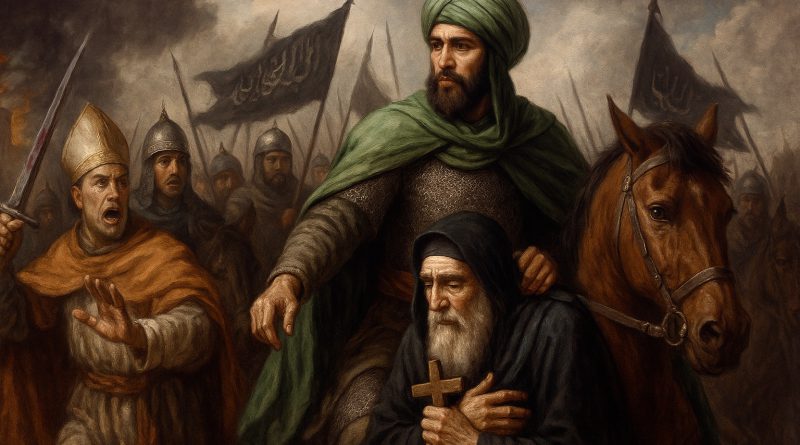Islam in Egypt: How Coptic Christians Welcomed Muslims After Byzantine Brutality
For the Coptic Christians, Islam’s early presence offered more than just respite—it provided dignity.
By the time Islam made its way into Egypt in the 7th century, the land of the Nile had already borne the weight of centuries of religious discord and political turbulence. Under the long shadow of the Byzantine Empire, Egypt was more than just a Christian province; it was a battleground of theological strife and imperial dominance.
Though both rulers and subjects were nominally Christian, a deep and painful schism divided them. The majority of Egypt’s native Christians—known as the Copts—rejected the conclusions of the Council of Chalcedon in 451 CE. This divergence in belief wasn’t a minor doctrinal dispute; it was a fundamental disagreement that cast the Copts as heretics in the eyes of Constantinople. Rather than engaging in dialogue or tolerance, the Byzantine response was persecution—systematic, brutal, and relentless.
Religious Repression Under Byzantine Rule
Tensions escalated sharply in the 7th century under the leadership of Cyrus of Alexandria, appointed both as Patriarch and imperial governor. Instead of being a spiritual shepherd, Cyrus became an enforcer of imperial orthodoxy. His mission was not unity, but conformity. And the price of non-conformity was steep.
Pope Benjamin I, a towering figure of the Coptic Church, was forced into hiding, evading capture for over a decade as Cyrus’s agents hunted him down. Monasteries were looted, sacred sites desecrated, and monks terrorized. Public worship under the Coptic rite became an act of resistance, and Coptic Christians were compelled to practice their faith in secret.
What began as theological enforcement morphed into state-sanctioned violence. Churches were confiscated or closed, and the spiritual life of an entire community was strangled. Ironically, in a land where both oppressor and oppressed were Christians, faith became a source of division, not unity.
Exhaustion and Hope: The Coptic Response to Muslim Entry
When Amr ibn al-As, one of Prophet Muhammad’s most trusted companions, led the Muslim army into Egypt in 639 CE, the reaction was not one of fierce resistance from the local population. Instead, many Egyptians, particularly the weary and persecuted Copts, saw a glimmer of hope.
This wasn’t about conversion or conquest. It was about survival.
The Muslim forces did not arrive with the intent of eradicating Christianity. In fact, quite the opposite occurred. The new rulers allowed the Copts to continue their religious practices, appoint their own patriarchs, and maintain a degree of autonomy in civil and religious matters. For a population worn thin by a century of religious tyranny, this was not just a policy change—it was a paradigm shift.
Historians such as Thomas Walker Arnold emphasize that early Islamic rule in Egypt was marked by a profound tolerance rarely seen in the religious politics of the time. No mass conversions were forced. No mass destruction of churches was carried out. The new rulers implemented the jizya tax—common to non-Muslims in Islamic governance—but in return offered protection, security, and religious freedom.
This approach shocked many who had only known imperial Christianity as synonymous with persecution.
A Strategic Coexistence Rooted in Justice
For the Muslim conquerors, this tolerance was not born out of weakness, but wisdom. The Islamic worldview emphasized justice (adl) and mercy (rahmah), and these values informed their governance. Islam’s emphasis on “no compulsion in religion” (Qur’an 2:256) wasn’t just recited—it was applied.
Amr ibn al-As is reported to have personally ensured the return of churches to the Coptic community and facilitated the reappearance of Pope Benjamin I from hiding. Such gestures were not merely symbolic—they were transformative. They reshaped the perception of Muslim rule from that of conquerors to custodians of justice.
This tolerance did not mean the complete absence of friction. There were taxes, administrative adjustments, and occasional tensions. But when compared with the brutality of Byzantine rule, Muslim governance felt like a reprieve to the Coptic population.
Legacy of Coexistence and the Shaping of Egyptian Identity
The Muslim entry into Egypt was not merely a military chapter; it marked a profound socio-religious shift that redefined Egypt’s cultural fabric for centuries to come. The experience of the Copts under early Islamic governance laid the foundation for a complex, layered identity—both Islamic and Christian, Arab and Egyptian.
This coexistence wasn’t perfect, nor was it always peaceful in the centuries that followed. But the contrast with the Byzantine era remains stark and instructive. Where imperial orthodoxy sought uniformity through force, early Islamic rule offered pluralism under protection.
Today, as Egypt continues to grapple with questions of religious identity, national unity, and historical memory, the events of the 7th century serve as a powerful reminder. They show that religious tolerance is not a modern invention but a historic principle—one that can thrive even amid conquest, so long as justice and humanity remain the guiding lights of governance.
A Lesson for Modern Times
The arrival of Islam in Egypt did not erase the Christian identity of the land. Rather, it allowed a deeply wounded community to heal, recover, and coexist. In an age when the term “tolerance” is often politicized or diluted, this historical moment stands out as an enduring lesson.
For the Coptic Christians, Islam’s early presence offered more than just respite—it provided dignity. And for the Muslim rulers, it was an opportunity to demonstrate the ethical and moral core of their faith in action.
At a time when the world is once again questioning how to reconcile faith and governance, history reminds us that compassion, justice, and pluralism are not weaknesses—they are the very foundations of enduring strength.



